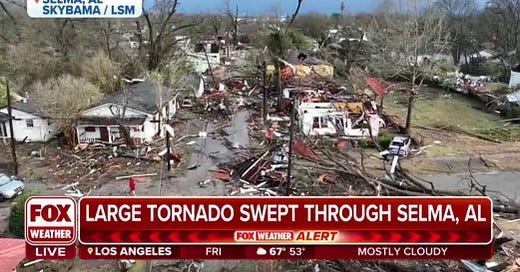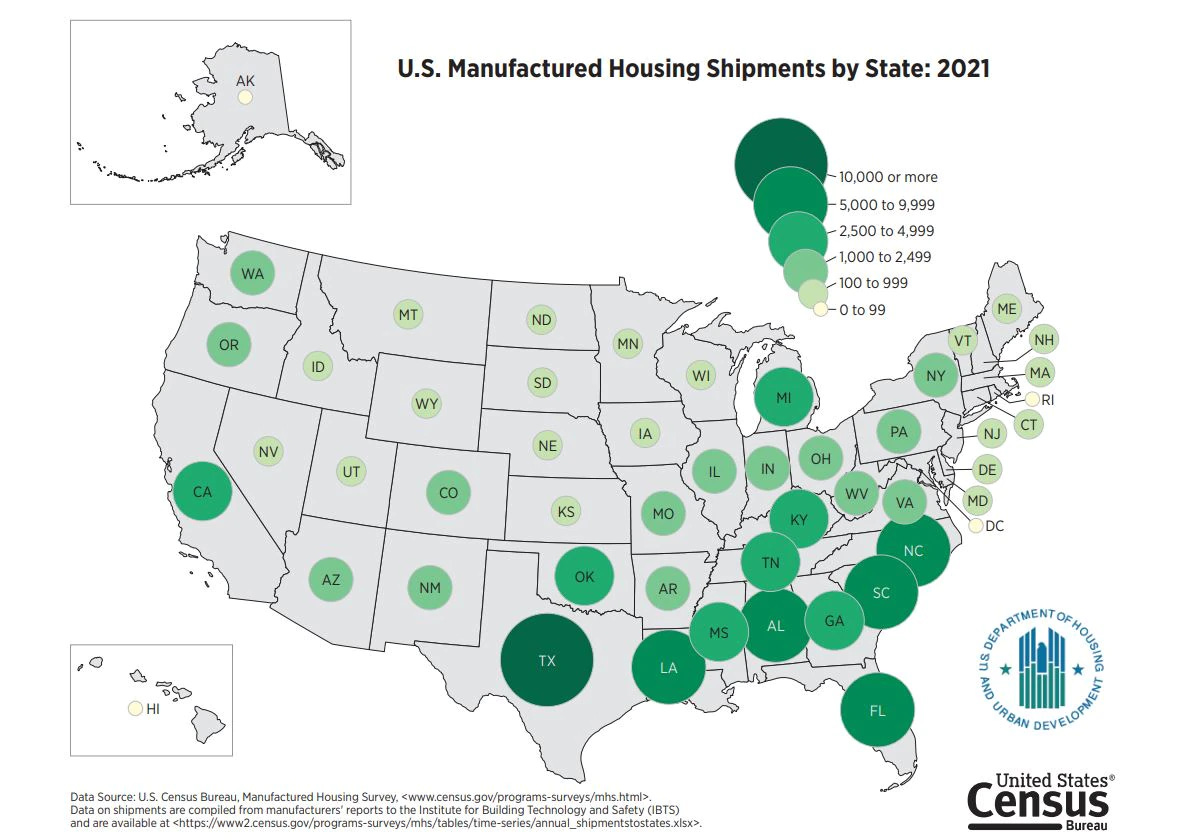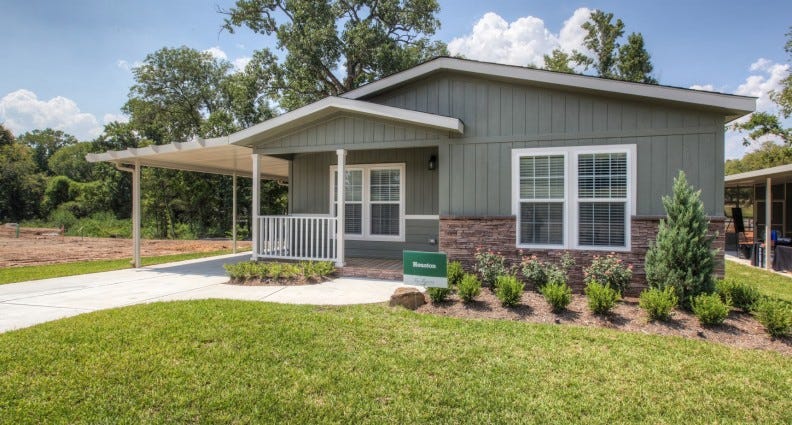Last week tornadoes swept through central Alabama, killing at least 9 people and injuring hundreds more.
This tragic story features an all-too-familiar character - mobile homes. Mobile homes are a common denominator in many tornado and hurricane fatalities. Many many fatalities. In fact, Strader and Ashley show that from 1985-2017, “54% of all housing-related tornado deaths” occurred in mobile home structures, despite making up only about 6% of the U.S. housing stock.1
If manufactured and mobile homes are so physically vulnerable, why do we allow them in places prone to tornadoes and hurricanes? In today’s newsletter I would like to talk about what manufactured housing is and why it is important in the American housing system. My goal is to highlight a fundamental paradox for policy-makers focused on community resilience - how should we balance the benefits of manufactured housing against its limitations?
What is a mobile/manufactured home?
Lets start with a few definitions, for the un-initiated. Manufactured housing is housing built in a factory on a permanent chassis and then transported to a site for installation. Manufactured homes are built according to standards set by the U.S. Department of Housing and Urban Development’s Manufactured Home Construction and Safety Standards code (a.k.a. the “HUD Code”), which became law on June 15, 1976. Manufactured homes are those built on or after June 15, 1976 - the date the HUD code became law - while those built prior are called mobile homes. The public (and many public officials) use these two terms (and sometimes the third term ‘trailer’) interchangeably, but there are in-fact important legal distinctions.



The HUD code itself has also evolved over time, most notably after Hurricane Andrew struck Florida in 1992 and destroyed 90% of mobile homes in South Dade County. The revised code set higher standards for wind resistance, anchoring, structural integrity, insulation, and weather-proofing - all intended to reduce losses to future disasters.
It is also important to note what types of housing are are not manufactured housing - including RVs, campers, park model homes, and modular housing. Each of these housing types is counted (and regulated) differently than manufactured homes.
So when we say “mobile home” or “manufactured housing,” we are actually referring to a highly diverse housing stock that ranges from old and dilapidated travel trailers and single-wides to modern versions that look, act and feel like site-built homes.
Where are manufactured and mobile homes?
Mobile and manufactured housing is especially prevalent in the Sunbelt, a region stretching across the southern United States from North Carolina and Florida in the east to Texas, Arizona and southern California in the west. In 2021 the largest shipments of new manufactured homes were concentrated in these states:
Mobile and manufactured homes also account for a large share of the housing stock in many places. In New Mexico, for instance, 15% of all occupied housing units are mobile or manufactured homes. Mobile and manufactured housing are an especially important component of the rural housing stock in the United States, accounting for roughly 14% of the occupied housing stock and a significant share of new housing starts.
It is also important to distinguish between mobile and manufactured homes (i.e. the housing type) and where mobile homes are located (i.e. location and tenure arrangements). About half of new manufactured homes are installed on private land or informal subdivisions while the other half are placed in land-lease communities called mobile home parks. This is an important distinction because the tenure arrangement and community context can shape many different aspects of disaster vulnerability like the quality of infrastructure, ability of the homeowner to access disaster funds, or whether the owner can title their home as real property.
Why manufactured housing?
Although the popularity of manufactured housing has waned over the past two decades, they still provide housing to more than 22 million Americans. Why do manufactured houses continue to be a major presence in the U.S. housing market?
There are many reasons, most notably cost. An analysis by my colleagues at the Urban Institute shows that new manufactured homes cost, on-average, about $57 per finished square foot (excluding land value), which is just over half the cost of new site-built homes ($108.10). It is no surprise, then, that the residents of manufactured housing tend to have lower incomes than site-built homeowners. About one-third of manufactured home residents earn less than $20,000 per year and 75% earn less than $50,000 per year. Durst and Sullivan find that 20% of households living in manufactured homes placed on private land are in poverty, while 31% of households in mobile home parks are - much higher than the poverty rate among conventional homeowners (9%) or renters (15%). The low-cost of manufactured housing also makes them appealing to certain demographic groups like first-time home buyers and seniors, who are disproportionately represented among the resident population.
Manufactured homes are also available, i.e. they can be produced in a factory and then transported to almost any site for installation. This means that they can often fill local cost and availability gaps in the housing market, especially in places where site-built construction is prohibitively slow or expensive.
Manufactured and mobile homes, especially those placed in mobile home parks, are also accessible to residents who may not have the financial or legal qualifications necessary to purchase private property, rent an apartment or receive publicly subsidized affordable housing.
Lastly, manufactured homes - whether placed on private land or in parks - also share many of the same amenities as single family homes that people value…not sharing walls, for instance, or having outdoor space to grill or plant a garden. Manufactured housing companies have also closed important amenity gaps with site-built housing, like energy efficiency and design flexibility, making them more competitive in the low-cost housing market.
Confronting the mobile home paradox
I titled this post ‘the paradox of mobile homes” because they present a unique policy challenge to state and local governments who want to reduce disaster and climate risk while also supporting/expanding/preserving affordable housing. As we have learned, manufactured and mobile homes are an important source of affordable housing in places where it is desperately needed. It is an important building block in the American housing system and provides housing opportunity for many socially vulnerable populations, including households with low-incomes, seniors, Latino households, and American Indian households.
And yet, our manufactured housing and mobile home stock performs poorly during extreme events, especially those involving high winds and flying debris. And it just so happens that the largest concentration of manufactured housing is in the Gulf Coast and southern United States, where tornadoes and hurricanes are routine threats.
After Hurricane Ian, Meet the Press host Chuck Todd asked Florida Senator Rick Scott a provocative question: should manufactured housing be banned in the state of Florida?
John Turner, the famed British architect and houser, urges us to see housing in its active context…to see housing as a verb i.e. what does being housed allow people to do? What resources and opportunities does housing afford, even when it is imperfect? In the context of Florida and the Sunbelt states, what is the value of manufactured housing to the people who rely on it, and if not manufactured housing…then what?
Safety is important in every context, but so is housing. In the absence of ready alternatives, we are thus faced with a paradox - when does the benefit of households living in affordable and accessible housing outweigh the relative risk to extreme events? There are no good answers, but I think it is a central question with relevance to many climate adaptation decisions that communities will need to make. Future posts will unpack some of the myriad risk factors faced by households in manufactured housing and how public policy might address them. I will also outline some of the important gaps in our knowledge about manufactured and mobile homes, information that we need before we can make sound policy decisions.
Learn More
Ash, Kevin, Michael Egnoto, Stephen Strader, Walker Ashley, David Roueche, Kim Klockow-McClain, David Caplen and Maurya Dickerson (2020). Structural forces: Perception and vulnerability factors for tornado sheltering within mobile and manufactured housing in Alabama and Mississippi. Weather, Climate and Society.
Lim, Jungmin, Scott Loveridge, Robert Shupp and Mark Skidmore (2017). Double danger in the double wide: Dimensions of poverty, housing quality and tornado impacts. Regional Science and Urban Economics.
Rumbach, Andrew, Esther Sullivan and Carrie Makarewicz (2020). Mobile home parks and disasters: Understanding risk to America’s third housing type. Natural Hazards Review.
Strader, Stephen and Ashley Walker (2018). Finescale assessment of mobile home tornado vulnerability in the central and southeast United States. Weather, Climate and Society.
Sutter, Daniel and Marc Poitras (2010). Do peopler respond to low probability risks? Evidence from tornado risk and manufactured homes. Journal of Risk and Uncertainty.
In 2021, the Census Bureau estimates that mobile and manufactured housing makes up about 5.2% of occupied housing units in the U.S.








Very sad, but hey, who can control or stop an "act of nature?" . . .
My gosh
***
The stigma that sometimes goes with mobile home ownership is not always deserved.
For some folks, mobile homes are just a necessity, or it just MAKES SENSE for their situation
Personally I have seem some mobile homes SO TRANSFORMED, so "upgraded", that I think they beat out a lot of 'normal homes', easily. Landscaping, upgrades, remodels, amenities, etc.
It depends on what the owners do with it :)
Do you own or live in a mobile home?
>>Stand strong !! :) You are part of the American dream!!
https://cleanfixsellyourmobile.blogspot.com/
:) :) :)